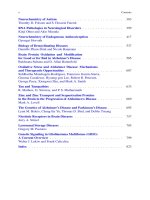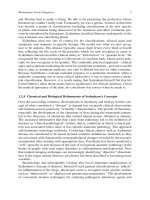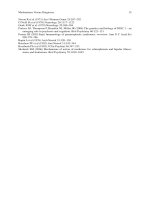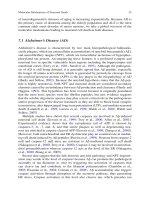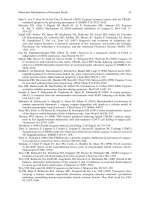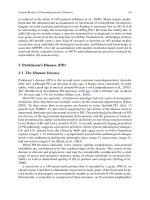Neurochemical Mechanisms in Disease P67 pot
Bạn đang xem bản rút gọn của tài liệu. Xem và tải ngay bản đầy đủ của tài liệu tại đây (122.45 KB, 10 trang )
Tauopathies 645
Ubiquitnylation
In addition to phosphorylation, tau is also subjected to ubiquitinylation. Ubiquitin is
a 76 amino acid protein that flags the proteins to be degraded in an ATP-dependent
manner. Ubiquinated tau has been found in inclusion bodies found in Pick’s disease
or Parkinson’s disease or in PHFs in AD.
Glycation: Proteins with slow turnover rates can be modified at lysine residues
by nonenzymatic reactions involving the condensation of a sugar aldehyde or ketone
group with the NH2-groups of the lysines. The products of this reaction can undergo
irreversible changes to form the advanced glycation end-products that can result in
the cross-linking of the modified proteins. Tau isolated from PHF is glycated, and
this glycation might be involved in the loss of microtubule binding and aggregation
of PHF into more complex aggregates possibly through receptors for AGE products
(RAGE) present on microglial cells and subsets of neurons (Ledesma et al., 1994;
Yan et al., 1994). AGE-tau conjugates may also more likely to form covalent cross-
links with each other.
Oxidation
The presence of one or two cysteines in the tau isoforms lacking or containing exon
10 has raised the possibility of tau forming dimers through the formation of inter-
molecular S–S bonds (Schweers et al., 1995). In this case, the oxidation of tau could
result in its aberrant aggregation.
Truncation
Tau truncation has been defined as the cleavage of tau that occurs at the glutamic
acid residue 391 (Wischik et al., 1995). This modification could facilitate aberrant
tau aggregation.
Deamidation
The deamidation of tau at asparagine (or glutamine) residues has also been described
and could also play a role in tau aggregation.
Prolyl Isomerization
The peptidyl-prolyl cis/trans isomerase Pin1 isomerizes the peptide bond of a phos-
phorylated serine or phosphorylated threonine followed by a proline. Through iso-
merization of pSer-Pro or PThr-Pro, Pin1 regulates a number of proteins. Together
with its ability to regulate phosphorylation and conformation of tau proteins, Pin1
is considered a potential neuroprotective function against AD.
2.4 Turnover of Tau Protein
Intracellularly, proteins are constantly being synthesized, modified, and after the
specific function is over, they are routed for degradation. Major factors that deter-
mine the half-life of proteins are the presence of signals that control its degradation
646 Mathew et al.
and stabilization. Among the signals for degradation, the presence of a specific
amino-terminal residue, the PEST sequence (a PEST sequence is a peptide sequence
which is rich in proline (P), glutamic acid (E), serine (S), and threonine (T)), and
the destruction box must be considered. PEST sequences are present in the tau
molecule, whereas the tubulin-binding region is a glycine-rich sequence. However,
little is known about the implication of these two regions in the stability of the tau
protein. Of the stabilization signals, amino acid repeats containing polyglutamine,
glycine, or alanine residues are among the most common.
The existence of ubiquitin-independent proteosomal degradation of tau protein
has been reported based on the fact that tau protein is degraded by the 20S pro-
teasome in vitro (David et al., 2002). However, there is strong evidence of tau
degradation by the ubiquitin–proteasome system (UPS) after ubiquitylation of the
protein. The degradation of tau by different proteases has been studied including
cleavage by caspases. Tau is also a substrate of the calcium-activated protease
calpain, although phosphorylated tau is more resistant to proteolysis by calpain
degradation than unphosphorylated tau. Cathepsin D has been shown to cleave tau
proteins, generating fragments similar to those found in NFT. HSP-27 is a protein
that facilitates degradation of pathogenic hyperphosphorylated tau by an unknown
mechanism.
3 Tauopathies
Neurodegenerative diseases with filamentous inclusions can be classified into these
groups: (i) tauopathies, (ii) alfa-synucleinopathies, (iii) polyglutamine disorders,
and (iv) ubiquitin disorders. Tauopathy is the most common group (Tolnay and
Probst, 1999). All these diseases have in common the presence of aberrant tau
aggregates. Tau was first implicated in the pathogenesis of Alzheimer’s disease
when it was discovered to be a major component of the neurofibrillary tangle
(Lovestone and McLoughlin, 2002). Subsequently the occurrence of neurofibril-
lary tangles in a wide range of conditions led to the suggestion that tau deposition
may be an incidental nonspecific finding associated with cell death or cellular dys-
function. Later the discovery of close to 20 different mutations in tau in FTDP-17
clearly showed that dysfunction of tau protein causes neurodegeneration and demen-
tia (Spillantini and Goedert, 2000). Table 2 gives a list of diseases grouped under
tauopathies. Overlap of some clinical and histopathological features occurs between
tauopathies. For example, neurofibrillary tangles (NFT) can be seen in AD, FTDP-
17, progressive supranuclear palsy (PSP) and neuropil threads can be seen in AD,
cortico-basalganglionic degeneration (CBD), FTDP-17, and PSP. Silver impregna-
tion technique usually detects most of the tau inclusions. Immunohistochemistry
with monoclonal antibodies against phosphorylated or nonphosphorylated epi-
topes of tau, however, are invaluable f or detecting the full extent of tau
deposition.
Immunohistochemical studies have also revealed tau-positive glial inclusions
in both oligodendrocytes and astrocytes in most, although not in all tauopathies
Tauopathies 647
Table 2 Neurodegenerative disorders with abundant filamentous tau inclusions
Dementia Syndromes
Parkinsonism Plus
Syndromes
Neuromuscular
Disorders
Genetic/Metabolic
Disorders
Alzheimer’s disease
Tangle-only dementia
Argyrophilic grain
disease
Pick’s disease
Presenile dementia
with tangles and
calcification
Progressive subcortical
gliosis
Familial
frontotemporal
dementia and
Parkinsonism linked
to chromosome 17
Subacute sclerosing
panencephalitis
Gerstmann–Straussler–
Scheinker disease
with tangles
Prion protein amyloid
angiopathy
Corticobasal
degeneration
Progressive
supranuclear palsy
Multiple system
atrophy
Postencephalitic
Parkinsonism
Dementia pugilistica
Amyotrophic lateral
sclerosis with
Parkinsonism
Dementia complex of
Guam
Non-Guamanian motor
neuron disease with
neurofibrillary
tangles
Myotonic dystrophy
Inclusion body
myositis
Down’s syndrome
Hallervorden–Spatz
disease
Niemann–Pick disease
type C
Modified from Tolnay and Probst (1999), Trojanowski and Lee (2002), and R obert and
Mathuranath (2007).
(Tolnay and Probst, 1999). Among the tauopathies, the most studied is AD. The
analyses of other types of dementia with tau pathology have usually been performed
in comparison with AD (Spillantini and Goedert, 2000). Based on electrophoretic
pattern, several classes of tau aggregation are presently described. (1) AD and
Parkinsonism dementia complex (six tau isoforms); (2) PSP and CBD (three iso-
forms with exon 10 corresponding sequence); (3) Pick’s disease (PiD) (three
isoforms without exon 10), and (4) myotonic dystrophy-the shortest tau isoform
(Caparros-Lefebvre et al., 2002).
3.1 Frontotemporal Dementia
3.1.1 Spectrum
Frontotemporal dementia (FTD) is one of the common forms of primary degen-
erative dementias after Alzheimer’s disease and can affect presenile individuals.
It is a clinically heterogeneous disorder characterized by alterations in language
and/or behavior. Rarely it may be associated with Parkinsonism or amyotrophy.
Depending on the initial and core clinical feature FTD is further classified into pri-
mary progressive aphasia (PPA) when language impairment is the initial and core
648 Mathew et al.
feature, frontal variant FTD (fvFTD) when behaviour and personality are the ini-
tial and core features, and FTD with Parkinsonism (FTDP) when Parkinsonism
is an associated initial and core feature in fvFTD and FTD with amyotrophy
when muscle amyotrophy attributable to spinal motor neuron involvement is an
associated initial and core f eature in fvFTD. PPA is further subclassified as pro-
gressive nonfluent aphasia (PNFA) if initial language impairment is expressive
aphasia and as semantic dementia (SD) if the initial language impairment is sensory
aphasia.
3.1.2 Clinical Features
FTD occurs most commonly between the ages 45 and 65 years. There is an equal
incidence in men and women. The mean duration of illness is 8 years ranging from
2 to 20 years. A family history of dementia is present in about half of cases. In
fvFTD the salient clinical characteristic is a profound alteration in character and
social conduct. The behavioural disorders consist of decline in personal hygiene and
grooming, mental rigidity and inflexibility, distractability and impersistence, hyper-
orality and dietary changes, perseveration and stereotypy, and utilization behaviour.
There will be early emotional blunting and loss of insight. Language abnormality
consists of altered speech output, stereotypy of speech, echolalia, perseveration, and
mutism (Snowden et al., 2002). On cognitive testing the patients show attentional
deficits, poor abstraction abilities, difficulty shifting mental set, and a tendency to
perseveration. Other cognitive domains including memory, praxis, and visuospatial
skills remain relatively preserved early in the disease. In PNFA, speech production
is effortful with phonological and grammatical errors and word retrieval difficul-
ties. In SD there is a naming and word comprehension problem although speech
expression remains fluent, effortless, and grammatical. Behavioral changes occur in
all subtypes of FTD as the disease progresses. Clinical diagnosis of various types of
FTD is based on consensus criteria (Neary et al., 1998).
3.1.3 Neuropathology
The typical changes seen in all subtypes of FTD are atrophy of the prefrontal and
anterior temporal neocortex. The subtype determines the distribution of the pathol-
ogy. In FTD there is prominent bilateral and usually symmetrical involvement of the
frontal lobes. In PNFA, atrophy is asymmetric, involving chiefly the left frontotem-
poral lobes, concentrated in Broca’s area. In SD, atrophy is typically bilateral and is
most marked in the anterior temporal neocortex, with inferior and middle temporal
gyri being predominantly affected (Snowden et al., 2002).
Histology shows neuronal loss from superficial cortical layers with spongio-
sis and variable degrees of gliosis with or without Pick cells or Pick bodies
(Mathuranath et al., 2000).
Pathologically, FTD is heterogeneous; some cases may show tau- or ubiquitin-
positive inclusions, or rarely they may lack distinctive histological features.
Sensitive methods for detecting tau abnormalities and ubiquitin are essential in the
neuropathological evaluation of FTD (Josephs, 2007).
Tauopathies 649
3.1.4 Neurochemistry and Neurobiology
Tau mutations have been well characterized in FTDP-17. The mutations described
are missense, deletion, or silent mutation in the coding region or intronic mutation
located close to exon 10. Coding region mutations are located in the microtubule-
binding repeat region or close to it. Mutation in exon 10 affects only 4R isoforms
whereas mutation in exons 9, 12, and 13 affects all isoforms. Coding region muta-
tions reduce the ability of tau to interact with microtubules. Intronic mutation leads
to a net increase in 4R isoforms. This leads to filamentous tau pathology (Spillantini
and Goedert, 2000). Bird et al. described three separate families with frontotemporal
dementia, having the same molecular mutation in exon 10 of the tau gene (P301L).
However, differences were seen in clinical features as well as pathological findings
among diseased members of the family, in spite of the same mutation in all. This
led to the suggestion that in addition to the mutation, there are other environmental
and/or genetic factors also influencing the phenotype (Bird et al., 1999).
FTD occurs in familial and sporadic forms; frontotemporal dementia and
Parkinsonism linked to chromosome 17 (FTDP-17) is one type characterized by
mutations in MAPT (gene encoding tau), which are inherited in an autosomal
dominant pattern. Its neuropathological hallmark is an abundance of hyperphospho-
rylated tau protein and degeneration of neurons and glia. In many cases of sporadic
frontotemporal dementia (FTD) and in FTD caused by tau mutations (FTDP-17)
there is disruption of the normal splicing of tau leading to the aberrant expres-
sion of tau isoforms and neurodegeneration. This suggests a central role for tau
in the pathogenesis of FTD. However, more than half the cases of sporadic FTD
show no tau deposition (Sutherland et al., 2007; Van Deerlin et al., 2007)ordis-
tinctive molecular pathological features involving the deposition of 3R tau protein.
However, there may be further tau polymorphisms that remain to be identified, out-
side the standard sequenced regions, which may have a role in the pathogenesis
of PiD. Furthermore, PiD can be distinguished immunohistochemically from other
tauopathies by the deposition of abnormally hyperphosphorylated tau, and by the
absence of phosphorylation of tau Ser262, which is specifically recognized by the
antitau antibody 12-E8 (Morris et al., 2002).
3.2 Alzheimer’s Disease
3.2.1 Clinical Features
Alzheimer’s disease (AD) is characterized initially by progressive loss of recent
memory and orientation. As the disease progresses, language, visuospatial, and
executive function can also be impaired with neurobehavioural abnormalities devel-
oping in the late stages. Typical cases have prominent early memory disturbances
and subsequent other cognitive abnormalities occur. Behavioural and psychological
symptoms develop during midstage of the disease and include delusions and hal-
lucinations, anxiety, sleep disturbances, and depression. Presentation and clinical
course are variable. In the majority of patients neurological examination other than
650 Mathew et al.
mental status examination will be normal. As disease progresses mild abnormali-
ties in tone and reflexes such as grasp, root, and suck reflexes are seen and at the
end-stage patient is mute, incontinent, and bedridden with swallowing difficulty and
flexion deformity. There are no diagnostic markers on blood examination. Diagnosis
can be established antimortem using established criteria with an accuracy of 90%
(Bradley et al., 2004).
3.2.2 Neuropathology
The outstanding gross pathology feature is hippocampal atrophy which is even
picked up on neuroimaging. Histopathology is characterized by reduced synaptic
density and neuronal loss in selected brain areas. The two molecular pathologies
that coexist in AD are amyloidosis and tau pathology. Amyloidosis consists of
extracellular aggregation of Aβ peptides into amyloid plaques. Tau pathology is
characterized by the intraneuronal aggregation of tau proteins into abnormal fila-
ments forming neurofibrillay tangles deposition that begins in the trans entorhinal
and entorhinal cortex and spreads from there to hippocampus, temporal neocortex,
and beyond that (Bradley et al., 2004). Amyloidosis is closely related to etiology
and tau pathology is strongly correlated to the clinical expression of the disease.
Little is known about the relationship between amyloid-β precursor protein (APP)
and tau pathologies (Delacourte et al., 2002). The quantification of Aβ in the
different brain areas demonstrates that the spreading pathway of tau pathology
remains constant, whatever the cortical distribution of Aβ aggregates (Delacourte
et al., 2002).
3.2.3 Neurochemistry and Neurobiology
Although there is a consensus that Aβ is upstream of tau in the pathological cas-
cade in AD there is little knowledge on either the nature of the interaction or how
direct it is. The relationship between Aβ toxicity and tau protein was identified in a
study where neurons knocked out of the MAPT gene were less toxic to Aβ neuro-
toxicity. As more and more of the relationship between amyloid-β precursor protein
(APP) and tau pathologies is emerging, one of the missing links in our fully under-
standing AD is being unravelled. The present section deals exclusively with the
neurofibrillary pathology in AD and related disorders.
Tau Hyperphosphorylation, Assembly of P-Tau, and Tau Pathology
Tau pathology corresponds to the intraneuronal aggregation of microtubule-
associated tau proteins into abnormal filaments. Paired helical filaments (PHF) are
the most characteristic cytoskeletal alterations affecting numerous neurons in AD.
Using a combined immunocytochemical and biochemical approach (Iqbal et al.,
1989) demonstrated for the first time that the microtubule-associated protein tau,
a normal brain cytoskeletal protein, is a component of the PHF. The authors also
indicated for the first time that posttranslational modification of tau such as phos-
phorylation might occur which would allow it to assemble either alone or together
Tauopathies 651
with other components of PHF (Iqbal et al., 1989). However, once the pathological
process is initiated, several factors join in making this disease course torturous to
follow.
The hyperphosphorylation hypothesis of AD was derived from the sequential
discoveries that the PHF-related proteins from AD brain are, in fact, persistently
phosphorylated forms of tau protein (Iqbal et al., 1989; Kosik et al., 1986). In
AD Thr-231, Ser-396 (adjacent to microtubule binding region), and Ser-262 (in
the microtubule-binding region) of tau protein are phosphorylated in PHF (Biernat
and Mandelkow, 1999; Biernat et al., 1992). Tau loses its biological activity
such as tubulin binding on hyperphosphorylation and becomes resistant to prote-
olytic degradation. This stability of PHF tau is conferred by increased levels of
transglutaminase-induced γ glutamyl lysine bonds which lead hyperphosphory-
lated tau aggregated into a high molecular weight polymeric complex. In AD, two
major classes of tau kinases are involved: tau kinase I (GSK3) and tau kinase II
(Cdk5). Prior phosphorylation by tau kinase I is followed by tau kinase II emphasis-
ing the role of tau kinase II (Cdk5) on tau phosphorylation in AD. There is evidence
that a dysregulation of Cdk5 as a result of proteolytic cleavage of its regulatory sub-
unit p35 by calpain yields a fragment p25 that allows constitutive activation of this
kinase, which appears to underlie NFT formation in AD.
The phosphorylation of tau may promote a conformational change, possibly
resulting in an increase in the number of α helices in the secondary structure of
tau which is confirmed by the observation that the content of α helices is greater in
tau isolated from PHF. This conformational change could involve the binding of the
amino terminal region of the tau molecule to its microtubule-binding region (Avila
et al., 2004). This facilitates its aggregation into PHF.
In a healthy neuron, phosphorylated tau is transported back (retrograde) to the
cell body from the axonal compartment where it is ubiquitinated and undergoes
proteolysis by the cell’s quality control machinery. Hyperphosphorylated tau cannot
be dephosphorylated by phosphatases such as PP2A and PP2B due to steric hin-
drance caused by the cross-linking. Hyperphosphorylated tau predominant in the
axonal compartment thus gets trapped.
In AD, heparan sulphate or other sulphated glycosaminoglycans induce p-tau to
dimerise followed by polymerisation, glycation, ubiquitination, and cross-linking
which leads to the formation of insoluble PHF. A high concentration of free p-tau
is required for assembly; often a deamidation facilitates polymerisation. The sulfo-
glycosaminoglycans (sGAG, polyanions), present along with tau in NFT accelerate
polymerisation of more p-tau. Sulphated glycosaminoglycans stimulate phospho-
rylation of tau by a number of protein kinases, and prevent tau from binding to
microtubules and from promoting microtubule assembly (Hasegawa et al., 1997).
Earlier studies have shown that heparan sulphate and hyperphosphorylated tau
colocalize in so-called “pretangle” neurones in AD brains, which suggests that
the accumulation of heparan sulphate precedes the hyperphosphorylation of tau
(Bancher et al., 1987; Braak et al., 1994). Other polyanions such as glutamate-rich
regions present in the C-terminal region of tubulin also facilitate aggregation, this
requiring the third tubulin binding motif of the tau molecule; hence 3R isoforms
652 Mathew et al.
only give rise to PHF (Perez et al., 1996). Moreover, the tau found in PHFs are
often ubiquitinated and glycated in AD (Ledesma et al., 1994)
Tau isoforms with three repeats assemble into PHFs, whereas tau isoforms
with four repeats assemble into SFs. It is proposed that oxidation of Cys to pro-
duce disulfide cross-linking favors tau assembly into PHF in tau3R molecules
whereas tau4R having 2 Cys may permit the formation of intramolecular S–S bonds,
and thus assemble into straight filaments (SFs; Barghorn and Mandelkow, 2002).
However, the interplay among phosphorylation as a targeting event, tau glycation,
oxidation, and heparan-mediated PHF formation remains to be elucidated. Excess
calcium influx seems one reasonable downstream mediator for Aβ-induced toxicity
that could explain the activation of certain kinases such as calcium–calmodulin-
dependent protein kinase II and transglutaminase that induce phosphorylation of
tau, inducing their aggregation into PHF (Johnson et al., 1997)
Neurobiology of NFT
It has been proposed that NFTs are an independent feature accumulating slowly
with age within the median temporal lobes. However, under the influence of altered
amyloid metabolism, which leads to the formation of βAmyloid plaques during
the initial stages of the disease, there is an acceleration of NFT formation that
spreads further to neocortex (Price and Morris, 2004). However, quantification of
Aβ in the different brain areas demonstrates that the spreading pathway of tau
pathology remains constant, whatever the cortical distribution of Aβ aggregates
(Delacourte et al., 2002). In AD brain, tau is abnormally hyperphosphorylated,
cleaved, and conformationally changed and is present mostly as PHF (Komori,
1999). Conformational changes in tau have been proposed to be among the earli-
est neurobiological changes in AD. Unlike normal tau, which contains two or three
phosphate groups, the cytosolic hyperphosphorylated tau from AD brain (AD P-
tau) contains 5–9 mol of phosphate/mol of the protein (Alonso et al., 2001). The
finding that phosphorylated tau fails to bind microtubules led to the hypothesis
that phosphorylated PHF tau was microtubule-assembly incompetent, leading to
the destabilisation of neuronal cytoskeleton and cellular demise (Mandelkow et al.,
1996)
In AD neurons, there are three main types of neurofibrillary lesions (NFLs)
according to their intracellular localization; neurofibrillary tangles (NFTs) inside the
cell body and apical dendrites, and neuropil threads (NThs) in distal dendrites and
dysrophic neurites, associated with senile plaques. Morphologically, three major
subtypes of NFTs can be distinguished, corresponding to different evolutionary
stages of these lesions.
1. Pretangle stage: The earliest stage is characterized by the accumulation of
hyperphosphorylated tau in the somatodendritic domain of affected neurons
without forming any PHF or SF. Pretangle neurons are nonargyrophilic and
therefore, only detectable with antitau antibodies (Bancher et al., 1987; Braak
et al., 1994)
Tauopathies 653
2. Classical NFT: In AD tau is hyperphosphorylated, cleaved, and conformation-
ally changed (Mondragon-Rodriguez et al., 2008). It is present mostly as paired
helical filaments (PHF). Conformational changes in tau have been proposed to
be among the earliest neurobiological changes in AD (Haroutunian et al., 2007).
Unlike normal tau, which contains two or three phosphate groups, the cytoso-
lic hyperphosphorylated tau from AD brain (AD P-tau) contains 5–9 mol of
phosphate/mol of the protein ( Alonso et al., 2001). The criteria for AD diag-
nosis have been revised to include the presence of tau pathology for diagnosing
definite AD. Neuropathologically, AD is defined by the accumulation of two
types of insoluble fibrous material–extracellular amyloid protein in the shape
of senile plaques and intracellular neurofibrillary lesions made of abnormally
and hyperphophorylated tau protein. The NFL consists of neurofibrillary tan-
gles, neuropil threads and dystrophic neurites associated with senile plaques.
Ultrastructurally NFL contains PHL as a major fibrous component and SFs as
a minor component. Both types are formed of the six brain tau isoforms that
are hyperphosphorylated. The mechanism of NFL formation in AD is only now
beginning to be understood. Tau is first phosphorylated, accumulates in cyto-
plasm, and then dimers form followed by polymers. Polymers form the globular
particles. As the concentration of globular particles increases, tau fibrils, PHFs,
and SFs appear (Fig. 2). Tau 3R isoforms assemble and give rise to twisted
PHFs with a diameter of 20 nm and Tau 4R isoforms give rise to SFs with
a diameter of 15 nm. In the ultrastructure of PHFs, the three microtubule-
binding regions are found in the core of the structure, making it inacces-
sible to antibodies raised against tubulin-binding region (Goedert and Klug,
1999).
Although globular tau particles were found in non-AD brain, their concen-
tration was lower and there were no filaments. This suggests that the trigger
converting a non-AD brain to an AD brain is the concentration of globular tau
particles. Unlike other tauopathies, glial tau pathology is only a minor feature
of AD (Tolnay and Probst, 1999). Typical NFTs comprising the PHFs and SFs
are identified by means of the silver staining technique (using Bielschowsky and
Gallyas stains).
3. Ghost tangles (tombstones): These comprise the extracellular residua of NFTs
after the degeneration of neurons.
Generally, the degree of dementia correlates with the sites and severity of
tau-based NFT accumulation (Holzer et al., 1994). Based on the manner of NFT
formation on various brain areas of the AD patient, during the course of disease
development, six neuropathological stages are defined.
Stages I and II (Transentorhinal stages) – Earliest NFTs are observed
in the entorhinal cortex and in this stage, patients are cognitively
unimpaired.
Stages III and IV (Limbic stages): Characterized by more extensive forma-
tion of NFTs in the entorhinal cortex and CA1 region of the hippocampus
and in this stage patients experience mild cognitive impairment (MCI, the
preclinical stage of AD)
654 Mathew et al.
Stages V and VI (Isocortical stage): Development of abundant NFTs in the
neocortex and the patients are diagnosed as AD in this stage
Interaction of ApoE and Tau
It is hypothesized that apoE isoforms may differentially influence tau pathol-
ogy. ApoE is the apolipoprotein constituent of chylomicron, which functions in
the transport and internalization of cholesterol and triglyceride-rich lipoproteins.
ApoE4 isoform is the most important known risk factor of AD. Apo E3, which
is considered to be neuroprotective can bind to the microtubule binding region
of nonphosphorylated tau. In vitro studies have shown that phosphorylation of
tau prevents this interaction supporting that apoE3 prevents hyperphosphorylation
of tau and thus reduces AD risk. The C-terminal bioactive fragments of apoE4
stimulate hyperphosphorylation of tau. This microtubule destabilization impedes
cellular transport leading to functional deficits and ultimately results in neuronal
loss (Goedert, 1993; Strittmatter et al., 1994).
ApoE4 can assume the “molten globule” conformation inside the late endo-
some due to the low pH as it possesses Arg residue in its 112 and 158 position.
In this state, the molecule attains increased permeability through the membrane
of late endosome and escapes into the cytosol, where it undergoes proteolysis by
AECE (Apo E cleaving Enzyme) generating truncated bioactive neurotoxic apoE4
fragments. These fragments interact with p-tau and neurofilament protein of high
molecular weight thus leading to the formation of pre-NFT-like filaments which are
deposited near the mitochondria. The toxic apoE4 fragments from the pre-NFT
complex bind on the F0–F1 ATPase of mitochondria resulting in mitochondrial
dysfunction and thus disrupting the energy metabolism of neuron (Huang and
Stultz, 2007).
Cell Cycle Re-Entry Hypothesis – Role of Tau
The latest and inevitably the most controversial theory for the pathogenesis of AD
is the “cell cycle re-entry hypothesis” which postulates that the formation of amy-
loid plaques and NFT is due to the reactivation of cell division like phenomena in
the aging neurons. When the cellular signals controlling the connectivity/synaptic
plasticity of a healthy neuron which is integrated in a synaptic network is lost, it re-
enters the cell cycle and attempts to proliferate, but G1 arrest halts its progression
through the cell cycle, thus resulting in cell death, which could be the mechanism
by which age-related neuronal death occurs in the CNS.
In AD neurons, the G1/S regulatory mechanisms seem to be absent/fail and these
neurons are allowed to progress through DNA replication into the G2 phase of the
cell cycle. One of the prominent features of the G2 phase is the activation of kinases
such as MAP Kinase and Cdk2&5, required for pushing the cell through division.
The MAP Kinase initiates mitotic re-entry and Cdk2&5 ensure the cell cycle pro-
gression. The activation of these kinases is associated with a downregulation of
phosphatases and a gradual destabilisation of the microtubule system in an attempt
to prepare the cell for cytokinesis. This destabilisation of microtubules results in an


